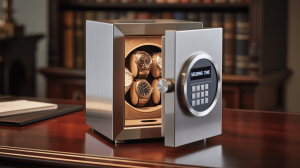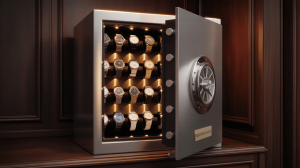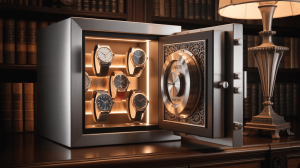Top Features to Look for in a Safe for Watches. But here’s the kicker… Your prized timepieces need more than a drawer—they require tailored protection. The right safe combines theft resistance, climate control, and convenience to keep watches secure and ready to wear.
1. Certified Burglary Resistance
A true watch safe boasts certified ratings—UL RSC or ETL—for burglary. Reinforced steel walls, anti‑pry doors, and robust locking bolts slow or deter professional thieves.
| Feature | Rating Standard | Benefit |
|---|---|---|
| Steel Wall Thickness | 12–14 gauge | Resists drilling |
| Locking Bolts | 4–6 large bolts | Prevents forced entry |
| Pry‑Resistant Door | Anti‑pry seams | Stops lever attacks |
2. Fireproof Insulation
Watches suffer heat damage above 350 °F. Look for UL 72 Class 350 ratings of 30–60 minutes at 1,200–1,400 °F. Intumescent gaskets seal out smoke and heat, preserving lubricants and delicate components.
3. Climate and Humidity Control
Leather straps and metal movements require stable humidity. An IP54 or higher seal blocks dust and moisture. Built‑in desiccant chambers or digital hygrometers maintain 40–50% RH, preventing corrosion and strap cracking.
4. Interior Organization and Padding
Modular interiors let you switch between watch pillows, strap slots, and winder modules. High‑density foam or velvet cushions cradle each case, preventing scratches and movement during opening.
| Organizer Component | Purpose | Advantage |
|---|---|---|
| Watch Pillows | Secure cradle | Prevents dings |
| Foam Inserts | Custom compartment layouts | Fits various watch sizes |
| Strap Slots | Store extra bands | Keeps accessories neat |
5. Integrated Watch Winder Options
If you own automatics, choose winders with programmable turns‑per‑day (TPD), directional control, and pause intervals. Low‑vibration motors (< 25 dB) ensure quiet, precise winding without over‑stress.
6. Lock Access and Backup
Electronic keypads offer multiple user codes and time‑delay features. Biometric scanners grant one‑touch entry. Always include a mechanical override key or combination fallback for emergencies.
7. Smart Connectivity Features
Bluetooth or Wi‑Fi integration brings alerts for tampering, door openings, and low batteries. Smartphone apps allow remote lock/unlock, audit logs, and winder adjustments for true peace of mind.
| Smart Feature | Notification Type | Benefit |
|---|---|---|
| Tamper Alerts | Push notification | Immediate security awareness |
| Remote Lock/Unlock | App control | Convenience |
| Audit Logs | Access history | Accountability |
8. Power and Backup Systems
Most safes run on AA batteries, with low‑battery warnings. USB‑rechargeable packs reduce waste. Solar trickle charging is emerging. A manual key ensures access if electronics fail.
9. Noise and Vibration Damping
Even premium winders can hum. Look for rubber‑dampened mounts and motor enclosures rated under 25 dB. Quiet operation makes safes suitable for bedrooms or offices.
10. Aesthetic Finishes and Materials
Safes now match décor—matte black, satin white, wood veneer, or leather wraps. Interiors may feature carbon‑fiber or wood panels. Luxury finishes turn a safe into a display piece, not an eyesore.
| Finish Option | Visual Appeal | Durability |
|---|---|---|
| Matte Black | Modern minimalist | Scratch‑resistant |
| Wood Veneer | Warm luxury | Requires gentle care |
| Leather Wrapped | Rich texture | Stain and wear resistant |
11. Size, Capacity, and Modularity
Compact safes hold 2–6 watches; larger cabinets accommodate 8–12 plus accessories. Modular trays let you reconfigure slots for winders, straps, or tools as your collection grows.
12. Installation and Anchoring
Proper anchoring prevents safe removal. Use supplied mounting kits for floors, walls, or furniture integration. Conceal bolts under lining for stealth.
| Installation Method | Security Level | Tools Needed |
|---|---|---|
| Floor Bolting | Very high | Drill, concrete anchors |
| Wall Mounting | High | Stud finder, screws |
| Furniture Integration | Very high | Mounting brackets |
13. Maintenance and Support
Monthly dusting and quarterly lock tests keep your safe functioning. Replace batteries every 6–12 months. Choose brands with 2–5 year warranties and responsive customer support for repairs or parts.
14. Budget and Value Balance
Entry‑level watch safes start around $150 with key locks and basic fire rating. Mid‑range ($300–$600) adds electronic locks and climate control. Premium ($600+) models offer smart connectivity and luxury finishes.
| Price Tier | Core Features | Ideal Collector |
|---|---|---|
| $150–$300 | Basic security, foam | New enthusiasts |
| $300–$600 | Fire rating, keypad | Serious collectors |
| $600+ | Biometric, smart features | High‑end connoisseurs |
15. Final Decision Checklist
Compile your must‑haves—security ratings, fire protection, climate control, winder capabilities, aesthetics, and budget. Compare certified models side‑by‑side to find the best match for your collection and lifestyle.
Conclusion
Selecting the perfect watch safe means balancing security, preservation, and style. Ready for the good part? Prioritize certified burglary and fire ratings, tailored interiors, and smart features to protect your timepieces in style and confidence.
FAQ
Q1: What burglary rating is essential?
Aim for UL RSC or equivalent for residential security.
Q2: Do all safes include winders?
No—only hybrid models list integrated winder options.
Q3: How deep should the safe be per watch?
Allocate ~2 inches width and 1.5 inches height per pillow.
Q4: Are smart features necessary?
Optional, but they enhance real‑time security awareness.
Q5: Is professional installation required?
DIY anchoring works; ensure you mount into studs or concrete for best security.







